

A Successful but Underused Strategy for Reducing Low-Value Care: Stop Paying for It. Waste in the United States health care system owing to overtreatment or low-value care is estimated at $75.7 billion to $101.2 billion.1 These estimates are likely a fraction of the actual spending because “tests beget tests” and often unnecessary procedures.
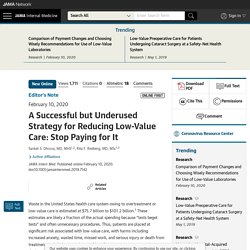
Thus, patients are placed at significant risk associated with low-value care, with harms including increased anxiety, wasted time, missed work, and serious injury or death from treatment, with little or no chance of benefit. In health care, does 'hot spotting' make patients better? [No] The new health care practice of "hotspotting" -- in which providers identify very high-cost patients and attempt to reduce their medical spending while improving care -- has virtually no impact on patient outcomes, according to a new study led by MIT economists.
![In health care, does 'hot spotting' make patients better? [No]](http://cdn.pearltrees.com/s/pic/th/hotspotting-sciencedaily-211701136)
The finding underscores the challenge of reducing spending on "superutilizers" of health care, the roughly 5 percent of patients in the U.S. who account for half the nation's health care costs. The concept of hotspotting, a little more than a decade old, consists of programs that give at-risk patients sustained contact with doctors, other caregivers, and social service providers, in an attempt to prevent rehospitalizations and other intensive, expensive forms of care. The MIT study was developed in cooperation with the Camden Coalition of Healthcare Providers, which runs one of the nation's best-known hotspotting programs.
Waste in healthcare spending. Price comparison commonly rx drugs mb 2019 4. Untitled. Untitled. The US Food and Drug Administration (FDA) approved denosumab to prevent skeletal-related events in patients with multiple myeloma on January 5, 2018, based on the results of a noninferiority trial.1 However, denosumab requires a more frequent dosing schedule and is much more expensive than standard bisphosphonate therapy.2 Denosumab discontinuation is associated with rapid bone loss, and patients who discontinue denosumab therapy will likely require subsequent treatment with bisphosphonates to limit anticipated bone loss.2,3 Therefore, its routine use is difficult to justify except in patients with renal dysfunction or in those unable to tolerate bisphosphonates.
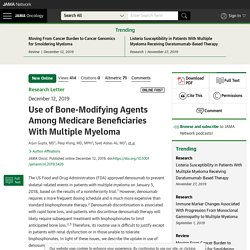
The Huge Amount of Waste in the U.S. Health System. Teresa Rogstad of Humana and Natasha Parekh, a physician with the University of Pittsburgh, were co-authors of the study, which combed through 54 studies and reports published since 2012 that estimated the waste or savings from changes in practice and policy.
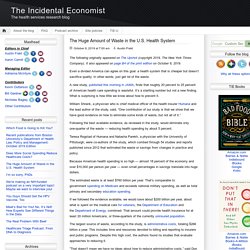
Because American health spending is so high — almost 18 percent of the economy and over $10,000 per person per year — even small percentages in savings translate into huge dollars. The estimated waste is at least $760 billion per year. That’s comparable to government spending on Medicare and exceeds national military spending, as well as total primary and secondary education spending. If we followed the evidence available, we would save about $200 billion per year, about what is spent on the medical care for veterans, the Department of Education and the Department of Energy, combined.
That amount could provide health insurance for at least 20 million Americans, or three-quarters of the currently uninsured population. End-of-life medical expenses. The funding and delivery of end-of-life care raise important economic and moral issues (e.g.
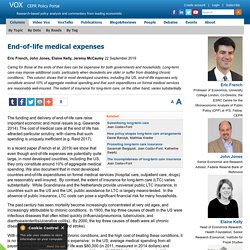
It’s all in the details... or is it? Biosimilars versus biologics for inflammatory conditions. Jamanetwork. Question What is the annual incremental cost to the Medicare Part D drug benefit program of using brand-name combination products instead of their generic components?
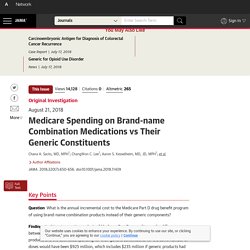
Findings In this retrospective analysis of Medicare Part D expenditures, the difference between the amount Medicare reported spending in 2016 on 29 brand-name combination products and the estimated spending for their generic constituents for the same number of doses would have been $925 million, which includes $235 million if generic products had been prescribed at the same doses, $219 million using generic substitution at different doses, and $471 million from substitution of similar generic medications in the same therapeutic class. Meaning Generic substitution and therapeutic interchange may offer important opportunities to achieve substantial savings. Richard Smith: Why the NHS shouldn’t be given more funds. Increased funding risks propping up a system that has to change A growing clamour of voices insists that the NHS is underfunded and should be given more money.

I disagree for two broad reasons. Firstly, the NHS does little for health. Doctors have no idea how much drugs cost — a Toronto physician wants to change that. Last month, Wigham had another heart attack.

At the hospital, she told doctors she had not taken the meds because she couldn’t afford them. Three days later, she was discharged with a prescription for the same costly drugs. “Doctors don’t have access to drug costs, so they were disempowered to talk to her,” says her family physician, Dr. Iris Gorfinkel. “They’re managing a heart attack, but not managing the primary problem, which is that she can’t afford the drugs.”
That’s why Gorfinkel is spearheading an initiative urging the province to mandate drug cost transparency — having prices pop up in the electronic medical record (EMR), so when doctors and nurse practitioners are writing prescriptions, they can discuss affordability with patients. Right now, when doctors write prescriptions, they see the name of the drug, but not the price. The Challenge of Addressing Low-Value Care Once It's Identified. Panelists discussed low-value care, unnecessary services, and what can be done to address overuse in healthcare during a panel at the University of Michigan Center for Value-Based Insurance Design’s (V-BID) annual V-BID Summit on March 14.
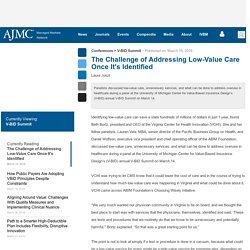
Identifying low-value care can save a state hundreds of millions of dollars in just 1 year, found Beth Bortz, president and CEO of the Virginia Center for Health Innovation (VCHI). She and her fellow panelists, Lauren Vela, MBA, senior director of the Pacific Business Group on Health, and Daniel Wolfson, executive vice president and chief operating officer of the ABIM Foundation, discussed low-value care, unnecessary services, and what can be done to address overuse in healthcare during a panel at the University of Michigan Center for Value-Based Insurance Design’s (V-BID) annual V-BID Summit on March 14. Wolfson added that the Choosing Wisely campaign defines overuse as when the risks outweigh the benefits with the support of evidence. Why should physicians give up pay raises to subsidize government waste? - CBC News. Last week, a story about a group of Quebec doctors rejecting a proposed pay raise garnered international attention.
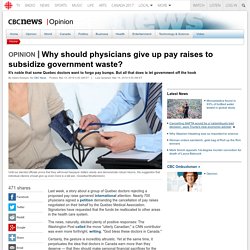
Nearly 700 physicians signed a petition demanding the cancellation of pay raises negotiated on their behalf by the Quebec Medical Association. Signatories have requested that the funds be reallocated to other areas in the health care system. The news, naturally, elicited plenty of positive responses: The Washington Post called the move "utterly Canadian;" a CNN contributor was even more forthright, writing, "God bless these doctors in Canada.
" Certainly, the gesture is incredibly altruistic. Yet at the same time, it perpetuates the idea that doctors in Canada earn more than they deserve — that they should make personal financial sacrifices for the sake of the system for which they work. Calculating Health Care Waste in Washington State. Overview “First, do no harm” is one of the principal rules for ethics taught in medical school. It means that it may be better not to do something than to do something that carries the risk of harm to the patient but a less certain chance of benefit. Wasteful Medical Care Runs Rampant. Drawn Ideas/Ikon Images/Getty Images It's one of the intractable financial boondoggles of the U.S. health care system: Lots and lots of patients get lots and lots of tests and procedures that they don't need. Women still get annual cervical cancer testing even when it's recommended every three to five years for most women.
Healthy patients are subjected to slates of unnecessary lab work before elective procedures. Doctors routinely order annual electrocardiograms and other heart tests for people who don't need them. Capitalism Ruins Documentation – medical minimalist. Each day I write a note in a patient’s chart, I have to go through a mental checklist. Did I document the presence or absence of enough symptoms? Did I document enough physical exam findings? Have I addressed enough problems in the plan?
Oversized Eyedrops Waste Medicine And Money. Gregory Matthews has glaucoma and uses prescription eyedrops. The dropper's opening creates a bigger drop than he needs, causing him to run out of his medication before the prescription is ready to refill. Matt Roth for ProPublica hide caption toggle caption. 'Direct care' could help ease medical costs - UPI.com. Sept. 29 (UPI) -- As a general surgeon I see patients every day who've had batteries of preventive and screening tests that, after all is said and done, yield nothing more than increased spending and increased anxiety.
Many doctors are unconcerned with the cost/benefit aspects of the treatments or tests they offer, and often abandon taking a detailed medical history and performing an extensive physical exam -- instead they rely on costly imaging studies to do the heavy lifting. I blame the third-party payer system. The healthcare consumer pays only 10 percent of every healthcare dollar directly out of pocket. The third party -- either an insurance company or Medicare -- pays the rest. With Medicaid the government is the third party and pays 100 percent of every dollar.
Value-based healthcare is sexy. A few days ago I was reminded yet again of the importance of words and how the way we use language has the ability to enthuse people....or switch them off entirely. Effect of a Price Transparency Intervention in the Electronic Health Record on Clinician Ordering of Inpatient Laboratory Tests: The PRICE Randomiz... Drug money: Cancer treatments cost as much as $33,000 a month, but fall well short of being wonder cures. The issue: Many new cancer drugs are prohibitively expensive but offer patients more hype than hope. Possible solutions: Regulators should require more patient benefit before approving cancer drugs, and tie their prices to how much they improve treatment. How Economic Incentives have Created our Dysfunctional US Medical Market. Report: U.S. Spends More Per Person On Health Care Than Any Country, Somalia Spends The Least : Goats and Soda. The United States spends the most on health care per person — $9,237 – according to two new papers published in the journal The Lancet.
Somalia spends the least – just $33 per person. Get What We Pay For? Hospitalized patients treated by physicians who order more or more expensive tests and procedures are just as likely to be readmitted or to die as patients treated by doctors who order fewer or less expensive tests, according to research led by Harvard Medical School and the Harvard T.H. Leaked report offers window into the medical one percenters and ‘growing concern’ over MD pay inequity. Even among doctors, it seems, there is the one per cent and the rest. Inequity in physician income is a growing concern that could fuel a “breakdown in collegiality,” over-delivery of certain services and unwanted intervention by governments, warns an internal Alberta Medical Association document.
The issue of “relativity” in doctors’ pay has percolated quietly for years throughout Canada, but the leaked report lays out the MD pay divide — and its potential fallout — with unusual frankness and detail. More than 400 of the province’s physicians bill over $1 million a year including overhead — while 4,000 doctors are billing $250,000 or less, notes the background paper, obtained by the National Post.
Variation in Physician Spending and Association With Patient Outcomes. Telehealth Makes Some Health Care More Expensive. Study Suggests High-Spending Doctors Could Do Less Without Harming Patients - WSJ. The Healthcare Imperative: Lowering Costs and Improving Outcomes: Workshop Series Summary. For these realities becomes that much more important as we move toward a bundled payment system, but today’s failures at patient engagement leave us far from the mark of where we need to be.
As an illustration, 4 years ago, one of my family members was diagnosed with a Stage 4 cancer, with a projected remaining life span of 120 days. Furthermore, there was less than a 30 percent chance that any intervention would be favorable. My family represents many well-informed healthcare consumers, and we asked the obvious questions, including “What are the costs for the care?” Yet, after 5 months, we still did not have an answer about the cost, and this was a family that was persistent, well educated, and well informed.
So as we begin to talk about bundled payments, we are indeed asking the nation to make a fundamental paradigm shift. The Strategy That Will Fix Health Care. Health Affairs. Breaking down Canada’s health-care silos: More money isn’t the answer - The Globe and Mail. GP rebate: What I do for the $37.05 that no one wants to pay. GetSharedSiteSession?rc=4&redirect= Billions wasted on drug spending in Canada, exclusive research shows - Health. Intervention Cost-Effectiveness: Overview of Main Messages - Disease Control Priorities in Developing Countries - NCBI Bookshelf. Costs and Consequences of Misdiagnosed Lower Extremity Cellulitis. Harmful medication prescribing to Canadian seniors costs $419M a year - Health.
Citizens' preferences on healthcare expenditure allocation: evidence from Greece - Xesfingi - 2015 - Health Expectations. The biggest source of waste in Canadian health care? The private, for-profit sector : Policy Note. Costs and Consequences Associated With Misdiagnosed Lower Extremity Cellulitis. How to Make the Affordable Care Act Affordable. Beyond petri dishes: Social, economic issues that affect health need more attention - Manitoba. The Costly Paradox of Health-Care Technology. Can cost-effective health care = better health care? Preventing Unnecessary Costs of Drug-Induced Hypoglycemia in Older Adults with Type 2 Diabetes in the United States and Canada. National Expenditure For False-Positive Mammograms And Breast Cancer Overdiagnoses Estimated At $4 Billion A Year. Is robotic surgery worth the cost? Association of Reference Pricing for Diagnostic Laboratory Testing With Changes in Patient Choices, Prices, and Total Spending for Diagnostic Tests.
The Challenge of Defining Low-Value Care. Low-Value Health Care Services in a Commercially Insured Population. Placebo effect of medication cost in Parkinson disease. Life expectancy vs health expenditure over time. High-Value, Cost-Conscious Health Care: Concepts for Clinicians to Evaluate the Benefits, Harms, and Costs of Medical Interventions. For-profit hospitals mark up prices by more than 1,000 percent because there's nothing to stop them. Association Between Availability of a Price Transparency Tool and Outpatient Spending. When Is It Ethical to Withhold Prevention? Achieving Value in Primary Care: The Primary Care Value Model. MEASURING LOW-VALUE CARE IN MEDICARE. From cost benefit to risk benefit? Small group of expensive patients account for most health spending - Health.
Training Physicians to Provide High-Value, Cost-Conscious Care: A Systematic Review. Injection sites such as Vancouver’s Insite are cost-effective, study shows. Article. How much money do we waste on useless health care? After Surgery, Surprise $117,000 Medical Bill From Doctor He Didn’t Know. Choosing Wisely: low value services, utilization, and patient cost sharing. Cost Effectiveness in Medicine is not a Dirty Word. Association between household food insecurity and annual health care costs. True cost of health care to average family is $11K per year: report. The hidden waste in Ontario health care. Forum shares creative ways to cut health care costs. INFORMING DISINVESTMENT: COBALAMIN DEFICIENCY IN THE FATIGUED. Eliminating Waste in US Health Care.